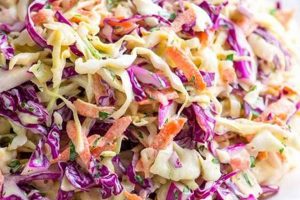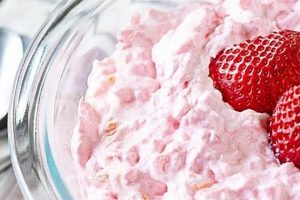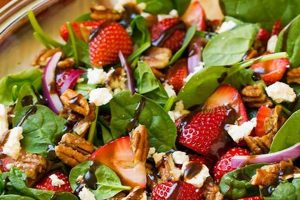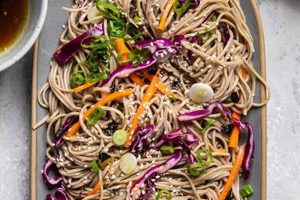A combination of fresh strawberries, walnuts, and leafy greens often forms the base of this dish. Variations frequently incorporate other ingredients such as crumbled cheeses (goat cheese, feta, or blue cheese), red onion, and other fruits like blueberries or mandarin oranges. A vinaigrette dressing, often balsamic-based, typically complements the sweet and savory flavors.
This type of salad offers a balance of nutritional value and appealing flavors. Strawberries provide Vitamin C and antioxidants, while walnuts offer healthy fats and protein. Leafy greens contribute fiber and various vitamins and minerals. The diverse ingredients create a texturally interesting and flavorful experience, making it a suitable dish for various occasions, from light lunches to elegant dinners. Historically, fruit and nut combinations in salads have been enjoyed across different cultures, highlighting the enduring appeal of fresh, seasonal produce.
The following sections will explore variations on this classic combination, offering insights into ingredient selection, dressing preparation, and presentation techniques for creating a memorable culinary experience.
Tips for a Delicious Strawberry Walnut Salad
Creating a truly exceptional strawberry walnut salad involves attention to detail and an understanding of how flavors and textures interact. These tips offer guidance for achieving optimal results.
Tip 1: Ingredient Selection Opt for fresh, ripe strawberries that are firm and fragrant. Look for walnuts that are plump and have a rich, nutty aroma. Avoid walnuts that appear shriveled or have a bitter taste.
Tip 2: Walnut Toasting To enhance their flavor, toast walnuts briefly in a dry pan over medium heat. This intensifies their natural nuttiness and adds a satisfying crunch.
Tip 3: Green Choices Consider using a mix of greens, such as spinach, arugula, and romaine lettuce, for a more complex flavor profile and textural variation.
Tip 4: Cheese Pairing Crumbled goat cheese or feta complements the sweetness of the strawberries and the earthiness of the walnuts. Blue cheese offers a bolder, more pungent option.
Tip 5: Dressing Preparation A balsamic vinaigrette is a classic choice, but other light vinaigrettes, such as poppy seed or raspberry vinaigrette, can also work well. Whisk the dressing ingredients together thoroughly to ensure proper emulsification.
Tip 6: Assembly Technique Add the dressing just before serving to prevent the salad from becoming soggy. Gently toss the ingredients together to coat them evenly.
Tip 7: Presentation Arrange the salad attractively on individual plates or a serving platter. Garnish with a few extra walnut halves and a sprinkle of fresh herbs, such as mint or basil, for an elegant touch.
By following these suggestions, one can elevate this simple salad to a sophisticated and satisfying dish, showcasing the harmonious blend of flavors and textures.
These techniques provide a foundation for culinary exploration and adaptation, encouraging creativity in the kitchen.
1. Fresh, Ripe Strawberries
Fresh, ripe strawberries constitute a crucial element in a successful strawberry walnut salad recipe. Their sweetness and juiciness provide a counterpoint to the other ingredients, creating a balanced flavor profile. The ripeness of the strawberries directly impacts the overall quality of the salad. Underripe berries lack sweetness and can be tart, while overripe berries become mushy and lose their structural integrity, detracting from the desired textural contrast. For instance, a salad made with firm, sweet strawberries offers a burst of fresh flavor that complements the nuttiness of the walnuts and the tanginess of the vinaigrette, while a salad prepared with bland, underripe strawberries or mushy, overripe ones will result in a less satisfying experience.
Selecting strawberries at peak ripeness involves considering several factors: vibrant red color, a pleasant aroma, and a slight yield to gentle pressure. These characteristics indicate optimal sugar content and juiciness. The use of fresh, in-season strawberries, whenever possible, further enhances the flavor profile. Strawberries purchased out of season may lack the desired sweetness and aroma. Furthermore, the preparation process emphasizes the importance of freshness. Gently washing and hulling the strawberries just before incorporating them into the salad preserves their delicate texture and prevents premature softening.
The emphasis on fresh, ripe strawberries underscores their significant contribution to both the flavor and overall quality of a strawberry walnut salad. This understanding allows for informed ingredient selection and preparation, contributing to a more enjoyable culinary experience. Attention to detail in selecting and handling this key ingredient ensures the salad delivers the intended balance of flavors and textures. This principle extends beyond the specific recipe, highlighting the broader importance of using fresh, high-quality ingredients in any culinary endeavor.
2. High-Quality Walnuts
Walnut quality significantly influences the overall success of a strawberry walnut salad recipe. Beyond mere presence, the characteristics of the walnuts contribute to texture, flavor complexity, and nutritional value. Substandard walnuts can detract from the salad’s appeal, while high-quality walnuts elevate the dish to a new level of culinary enjoyment.
- Flavor and Freshness
High-quality walnuts possess a rich, buttery flavor and a pleasant aroma, free from rancidity or bitterness. Freshness is paramount; stale walnuts can impart off-flavors that negatively impact the delicate balance of the salad. Fresh walnuts offer a clean, bright flavor that complements the sweetness of the strawberries and the tanginess of the vinaigrette. Conversely, stale or rancid walnuts introduce undesirable bitterness and can overwhelm the other flavors.
- Texture and Size
Walnut texture plays a vital role in the salad’s overall sensory experience. High-quality walnuts offer a satisfying crunch that contrasts with the softer textures of the strawberries and greens. Uniformly sized pieces ensure even distribution throughout the salad and contribute to a visually appealing presentation. Pieces that are too small can become lost among the other ingredients, while overly large pieces can disrupt the balance and make the salad difficult to eat.
- Appearance and Color
Visual appeal contributes significantly to the dining experience. High-quality walnuts exhibit a light, uniform color, free from blemishes or dark spots. Plump, unbroken walnut halves or pieces are preferred for their aesthetic contribution to the salad. Their visual presence enhances the overall presentation, making the salad more inviting. Conversely, walnuts with dark spots or broken pieces can detract from the visual appeal.
- Nutritional Value
Beyond flavor and texture, high-quality walnuts offer valuable nutritional benefits. They are a good source of healthy fats, protein, and antioxidants. Choosing high-quality walnuts ensures these nutritional benefits are maximized. Their inclusion in the salad contributes not only to flavor and texture but also to the overall nutritional value of the dish. This aspect aligns with the increasing emphasis on incorporating nutrient-rich ingredients into meals.
The selection of high-quality walnuts demonstrates an attention to detail that elevates the strawberry walnut salad from a simple dish to a carefully crafted culinary creation. The interplay of flavor, texture, appearance, and nutritional value contributes to a more satisfying and enjoyable dining experience. Prioritizing quality ingredients ensures that each component of the salad contributes positively to the final result.
3. Complementary Greens
Complementary greens play a crucial role in a strawberry walnut salad recipe, contributing texture, flavor, and visual appeal. Their selection impacts the overall balance and enjoyment of the dish. Leafy greens provide a foundation for the other ingredients, creating a bed of freshness that balances the sweetness of the strawberries and the richness of the walnuts. The choice of greens should consider factors such as flavor profile, texture, and visual contrast. For instance, spinach offers a mild, slightly sweet flavor and a tender texture, while arugula provides a peppery bite and a more robust structure. A mix of greens can create a more complex and interesting salad.
Several types of greens complement a strawberry walnut salad effectively. Baby spinach, with its delicate flavor and smooth texture, provides a neutral backdrop that allows the other ingredients to shine. Arugula, with its peppery notes, adds a contrasting element that enhances the overall flavor profile. Butter lettuce, with its soft, buttery texture, offers a luxurious mouthfeel. Romaine lettuce provides a crisp, refreshing counterpoint to the softer ingredients. The choice depends on the desired balance of flavors and textures. A combination of spinach and arugula, for example, offers both mildness and peppery notes, creating a dynamic interplay of flavors.
The selection of complementary greens demonstrates an understanding of flavor pairings and textural contrasts. The interplay between the chosen greens and the other ingredients creates a harmonious balance, elevating the salad from a simple combination of components to a cohesive culinary experience. Careful consideration of the greens’ characteristics ensures they contribute positively to the overall flavor profile, texture, and visual appeal of the strawberry walnut salad. This understanding allows for informed choices that enhance the overall enjoyment of the dish, aligning with the principles of culinary artistry and balanced nutrition.
4. Balanced Vinaigrette
A balanced vinaigrette is essential to a successful strawberry walnut salad recipe. It provides a unifying element, binding the diverse flavors and textures into a harmonious whole. The vinaigrette’s acidity cuts through the richness of the walnuts and complements the sweetness of the strawberries, while its other components contribute complexity and depth. A well-crafted vinaigrette elevates the salad beyond a simple combination of ingredients, transforming it into a cohesive culinary experience. The balance of sweet, sour, salty, and savory elements is crucial for achieving optimal results.
- Acidity
Acidity forms the backbone of a balanced vinaigrette. Vinegar, typically balsamic, red wine, or apple cider, provides the necessary tartness to counterbalance the sweetness of the strawberries and the richness of the walnuts. The level of acidity should be carefully calibrated to complement, not overpower, the other flavors. For instance, a balsamic vinaigrette with a slightly sweet profile complements the strawberries, while a red wine vinaigrette offers a sharper contrast. The acidity also helps to brighten the overall flavor profile of the salad.
- Sweetness
A touch of sweetness in the vinaigrette can further enhance the interplay of flavors. A small amount of honey, maple syrup, or even a pinch of sugar can balance the acidity and create a more nuanced flavor profile. This sweetness should be subtle, serving to enhance rather than dominate the other flavors. For example, a hint of honey in a balsamic vinaigrette complements the sweetness of the strawberries, while a touch of maple syrup can add a subtle depth of flavor.
- Oil
Oil contributes richness and mouthfeel to the vinaigrette. Extra virgin olive oil is a classic choice, offering a fruity flavor and a smooth texture. Other oils, such as walnut oil or avocado oil, can also be used to create different flavor profiles. The ratio of oil to vinegar determines the overall richness and texture of the vinaigrette. A higher proportion of oil creates a richer, more emulsified dressing, while a higher proportion of vinegar results in a lighter, more tart dressing.
- Seasoning
Seasoning is essential for enhancing the overall flavor profile of the vinaigrette. Salt and freshly ground black pepper are fundamental, balancing the other flavors and adding complexity. Other seasonings, such as Dijon mustard, minced garlic, or herbs, can further enhance the flavor profile. For example, Dijon mustard adds a subtle tang, while garlic provides a pungent note. Fresh herbs, such as mint or basil, can complement the strawberries and add a refreshing element.
The careful balance of these elements in the vinaigrette significantly impacts the overall success of the strawberry walnut salad. A well-crafted vinaigrette enhances the individual flavors of the ingredients, creating a synergistic effect where the whole is greater than the sum of its parts. The balance of acidity, sweetness, oil, and seasoning contributes to a more complex and enjoyable culinary experience, transforming a simple salad into a sophisticated dish.
5. Proper Assembly
Proper assembly is crucial for maximizing the sensory experience of a strawberry walnut salad recipe. It ensures the ingredients retain their optimal texture and flavor, contributing to a cohesive and enjoyable dish. Improper assembly can lead to a soggy salad with compromised flavors, diminishing the overall quality. The timing and order of combining ingredients significantly impact the final result.
- Timing of Dressing Application
Adding the vinaigrette immediately before serving prevents the delicate greens from wilting and becoming soggy. This preserves their crisp texture and vibrant appearance. Prematurely dressing the salad can lead to a less appealing and less palatable dish. This highlights the importance of timing in preserving the integrity of individual components.
- Ingredient Combination Order
The order in which ingredients are combined influences the overall balance and presentation of the salad. Heavier ingredients, such as walnuts and cheese, should be added after the greens to prevent them from sinking to the bottom. Distributing the strawberries evenly throughout the salad ensures each bite contains a balanced mix of flavors and textures. This attention to layering enhances both the visual appeal and the sensory experience.
- Walnut Incorporation
Toasted walnuts should be cooled completely before adding them to the salad to prevent them from softening the greens or melting the cheese. Their crisp texture provides a pleasant contrast to the other ingredients, and maintaining this crispness is key to a successful salad. The toasting process enhances the walnuts’ flavor, but the subsequent cooling period is crucial for preserving their textural contribution.
- Gentle Handling of Ingredients
Tossing the salad gently ensures even distribution of the vinaigrette and prevents damage to the delicate strawberries and greens. Overly vigorous tossing can bruise the strawberries and wilt the greens, negatively impacting both the appearance and texture of the salad. A delicate touch preserves the integrity of the individual components.
Proper assembly techniques, therefore, are essential for preserving the quality and enhancing the enjoyment of a strawberry walnut salad. Attention to detail in these steps maximizes the flavors, textures, and visual appeal of the dish, demonstrating a commitment to culinary excellence. The proper combination and timing of ingredients transform individual components into a cohesive and delightful culinary creation.
Frequently Asked Questions
This section addresses common inquiries regarding strawberry walnut salad preparation, offering practical guidance for achieving optimal results.
Question 1: Can other nuts be substituted for walnuts?
While walnuts offer a distinct flavor and texture profile, pecans, almonds, or candied pecans can be substituted. However, the overall flavor profile of the salad will change accordingly. Consider the flavor pairings with the other ingredients when selecting a substitute.
Question 2: How can one prevent the strawberries from becoming soggy in the salad?
Adding the dressing immediately before serving is crucial. Prematurely dressing the salad can cause the strawberries to release their juices and become soggy. Storing the strawberries separately until serving time also helps maintain their texture.
Question 3: What type of cheese pairs best with a strawberry walnut salad?
Crumbled goat cheese and feta are popular choices, complementing the strawberries and walnuts. Blue cheese offers a more pungent option for those who prefer a bolder flavor. Consider the overall flavor profile desired when selecting a cheese.
Question 4: Can this salad be prepared in advance?
While the individual components can be prepared in advancewashing and drying the greens, toasting the walnuts, and hulling the strawberriesthe salad should be assembled immediately before serving to prevent sogginess. The dressing should also be added just prior to serving.
Question 5: How long can leftover salad be stored?
Leftover salad, without dressing, can be stored in an airtight container in the refrigerator for up to one day. However, the texture and quality may diminish over time. It’s best to consume the salad as fresh as possible.
Question 6: What are some variations on the classic strawberry walnut salad recipe?
Incorporating grilled chicken or fish can transform the salad into a more substantial meal. Adding other fruits, such as blueberries or mandarin oranges, can provide additional flavor and nutritional value. Roasted vegetables, such as beets or sweet potatoes, can also be incorporated for added complexity.
Understanding these common points of inquiry facilitates successful strawberry walnut salad preparation and enhances overall culinary outcomes.
The following section delves further into recipe variations and advanced preparation techniques.
Strawberry Walnut Salad Recipe
Exploration of the strawberry walnut salad recipe reveals a dish reliant on the careful interplay of fresh, high-quality ingredients and precise assembly techniques. Emphasis on ripe strawberries, premium walnuts, complementary greens, and a balanced vinaigrette underscores the significance of each component. Proper timing in dressing application and ingredient combination ensures optimal texture and flavor preservation. From ingredient selection to final presentation, attention to detail elevates this seemingly simple salad to a sophisticated culinary creation.
This exploration encourages informed culinary choices, promoting an appreciation for fresh ingredients and balanced flavors. Adaptability within the recipe framework allows for personalized interpretations, fostering culinary creativity. Ultimately, understanding the foundational elements of this classic combination empowers individuals to create a truly exceptional and satisfying dining experience.






